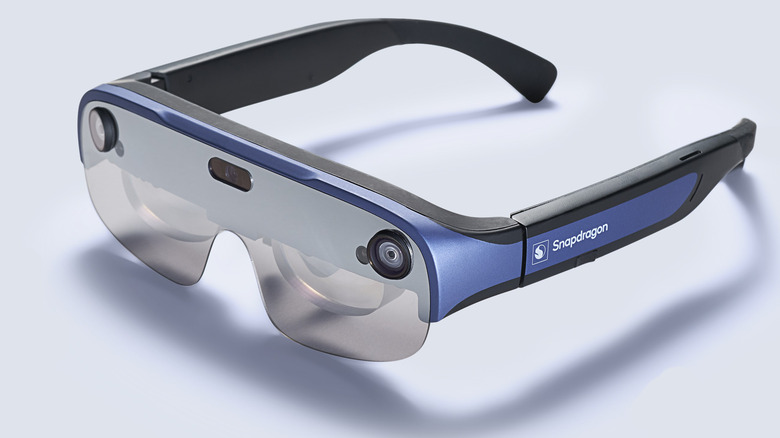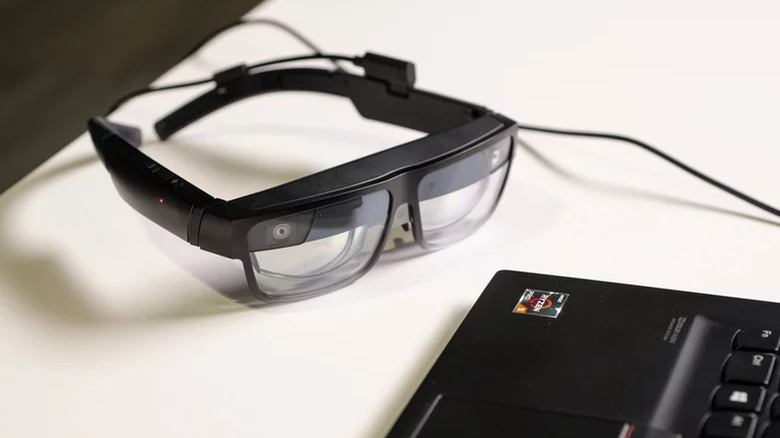Qualcomm Made Its New Wireless AR Smart Glasses A Little Less Dorky
Qualcomm has a new version of its augmented reality smart glasses, and though the Wireless AR Smart Viewer Reference Design may not be quite the sci-fi sunglasses the movies have promised us, they're certainly a little closer in design and functionality. Intended to demonstrate the mixed-reality potential of the Snapdragon XR2 Platform, the big improvement beyond the smaller, lighter design is that this new digital eyewear cuts the cord between glasses and phone.
The XR Platform Gen 1-based Smart Viewer was tethered, with a cable linking the glasses to a Snapdragon-powered smartphone. For 2022's reference design, Qualcomm snips that cord, instead relying on a 6GHz or 5GHz wireless link to the handset.
Resembling a set of chunky eyeglasses, the new headset is roughly 40% thinner in profile than the wired version. Qualcomm says its 115 gram weight has been better balanced, too, for more comfortable wear. The end result, the company concedes, still isn't at the point where those around you wouldn't notice these weren't ordinary sunglasses — and the roughly 30 minutes of battery life if you're using full-frame AR apps is far from ready for extended use — but it's an step forward nonetheless on the old design.
Wireless speed and low-latency is the key
While the connection may be wireless now — or, depending on OEM preference, optionally supporting a cable — the phone itself is still required. It handles the mixed-reality (XR) application, then sends compressed rendered frames over the wireless connection with the glasses. They, in turn, are responsible for recording 6DoF movement, any hand or eye tracking being carried out, and inputs from whatever controller might be used, and passing that back to the phone. The Snapdragon XR2 in the glasses then uses its GPU to show the AR content.
For that, it uses dual micro-OLED displays provided by SeeYa Technology. Each runs at 1920 x 1080 resolution, with a 90Hz refresh rate; there's a roughly 39-degree field of view. The reference design lacks eye-tracking, but Snapdragon XR2 supports it should an OEM want to include that as well.
As for other sensors, there are twin monochrome cameras for 6DoF tracking, and a color camera for streaming video from the headset. The wireless link comes courtesy of the Qualcomm FastConnect 6900 system, with Bluetooth 5.3 and WiFi 6/6E support; the XR2 Platform also includes 5G support. In an ideal configuration, with a FastConnect 6900 doing duty on both the headset and phone, latency should be minimal, Qualcomm says: there are things like preferential channel access and interference mitigation for the XR link, along with custom power modes for saving battery without introducing lag.
A consumer version still isn't decided
Since this is a reference design, of course, Qualcomm doesn't have any commercialization plans itself for the new smart glasses. Instead, it's leaving that up to its OEM partners; the Wireless AR Smart Viewer is really meant to be a shortcut, saving on development costs.
We've seen how that works before, with Lenovo opting to launch a product — the ThinkReality A3 headset — based on the previous, tethered design. Qualcomm isn't saying whether it already has any customers lined up for this new version, though even if a company steps up the end result may not look or function exactly like the viewer you see here.
As well as aesthetic changes, there are hardware considerations too. The most significant is likely to be around battery life: Qualcomm opted for a mere 650 mAh battery in the reference design, erring on the side of lightness and trimming bulk, with a secondary, tethered battery pack that could be clipped to a shirt or jacket for extending runtimes. However versions with larger batteries, or different expansion batteries could be added.
Similarly, control over the XR content is also down to the preferences of OEMs. That might include ring controllers or wristband-worn controllers; or, the headset could respond to voice or optional eye-tracking. Qualcomm is offering the reference design to its close partners now, with broader availability later in the year, though when — if ever — we'll see a consumer version of the smart sunglasses remains to be seen.

